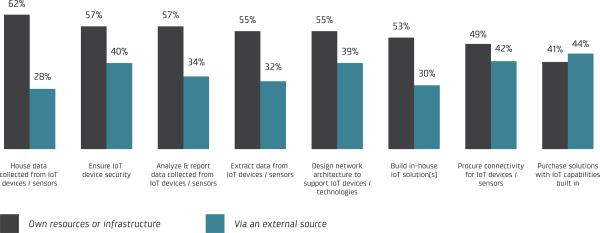17 November 2017
How IT pros plan to implement IoT. SOURCE: STATE OF IoT 2018, CRADLEPOINT
IoT adoption is growing globally with 69 per cent of organisations having adopted it or planning to do so within the next year, according to Cradlepoint.
But in a study carried out with Spiceworks, the wireless solutions specialist found that 40 per cent still have have serious concerns around cyber security.
For its State of IoT 2017-2018 business intelligence report, Cradlepoint surveyed 400 IT professionals in the US, Canada and the UK at companies with at least 500 employees across 22 industries. Respondents were all involved with IoT strategies and decisions within their organisations.
While cyber security remains the top concern for 40 per cent of respondents, Cradlepoint says a desire for increased physical security is the top driver for IoT adoption at 32 per cent.
This was followed by: improved operational processes (23 per cent); reduced opex (21 per cent); and simplified management (20 per cent).
Around 71 per cent of respondents who have already deployed IoT technologies said that they’re using them for building security, often through security cameras.
The study found that despite the rise of high-profile IoT attacks, nearly half of the organisations surveyed plan to rollout IoT deployments on existing enterprise networks, and 57 per cent prefer to manage their own IoT device security.
“Following the spread of IoT botnets like Reaper and Mirai, which infected millions of internet-connected security cameras, routers and digital video recorders, it’s evident that insecure IoT devices, even connected security devices, are putting organisations more at risk,” says Peter Tsai, senior technology analyst at Spiceworks.
“Before deploying network-connected devices that create more entry points for hackers to exploit, organisations should vet the security of all IoT devices they plan to introduce and ensure their company can adequately protect these devices from potential threats.”
In its report Cradlepoint says the Internet of Things demands a new way of networking. It believes that that the successful implementation of technologies requires an infrastructure engineered for the realities of the distributed and vast nature of connected devices.
It adds that security is one of the “greatest risks” presented by IoT technologies.
As a result, it advises businesses to make infrastructure and security updates with future IoT projects in mind.
Failure to do so could quickly render newly adopted infrastructure and security solutions “obsolete”, warns the company.
Ken Hosac, VP of IoT business development at Cradlepoint, says: “Companies that deploy IoT devices on their existing networks are significantly expanding their attack surface and creating new vulnerabilities to IoT-specific threats that traditional security tools are not equipped to handle.
“But the good news is that enterprises can leverage software-defined perimeter technology to spin-up virtual overlay networks, without trained specialists, that isolate IoT devices from existing networks – and other IoT devices, control access and shield them from being Internet-addressable.”










